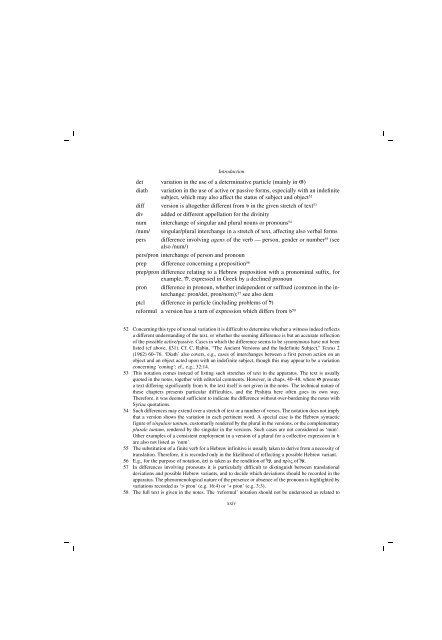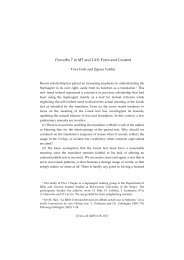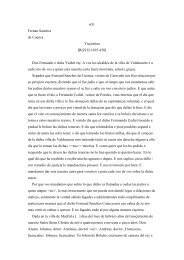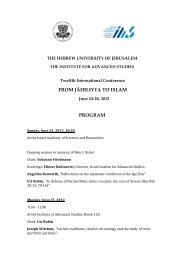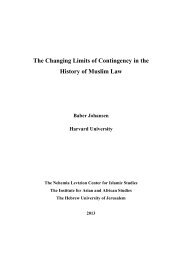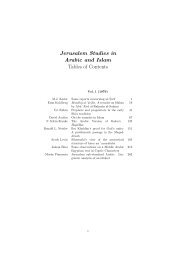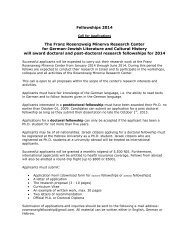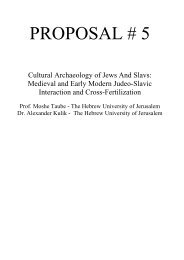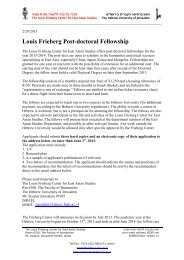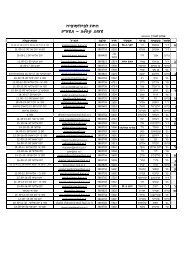THE BOOK OF EZEKIEL Moshe H. Goshen-Gottstein Shemaryahu ...
THE BOOK OF EZEKIEL Moshe H. Goshen-Gottstein Shemaryahu ...
THE BOOK OF EZEKIEL Moshe H. Goshen-Gottstein Shemaryahu ...
You also want an ePaper? Increase the reach of your titles
YUMPU automatically turns print PDFs into web optimized ePapers that Google loves.
Introduction<br />
det variation in the use of a determinative particle (mainly in ])<br />
diath variation in the use of active or passive forms, especially with an indefinite<br />
subject, which may also affect the status of subject and object 52<br />
diff version is altogether different from x in the given stretch of text 53<br />
div added or different appellation for the divinity<br />
num interchange of singular and plural nouns or pronouns 54<br />
/num/ singular/plural interchange in a stretch of text, affecting also verbal forms<br />
pers difference involving agens of the verb — person, gender or number 55 (see<br />
also /num/)<br />
pers/pron interchange of person and pronoun<br />
prep difference concerning a preposition 56<br />
prep/pron difference relating to a Hebrew preposition with a pronominal suffix, for<br />
example, el, expressed in Greek by a declined pronoun<br />
pron difference in pronoun, whether independent or suffixed (common in the interchange:<br />
pron/det, pron/nom); 57 see also dem<br />
ptcl difference in particle (including problems of l)<br />
reformul a version has a turn of expression which differs from x 58<br />
52 Concerning this type of textual variation it is difficult to determine whether a witness indeed reflects<br />
a different understanding of the text, or whether the seeming difference is but an accurate reflection<br />
of the possible active/passive. Cases in which the difference seems to be synonymous have not been<br />
listed (cf above, §31). Cf. C. Rabin, “The Ancient Versions and the Indefinite Subject,” Textus 2<br />
(1962) 60–76. ‘Diath’ also covers, e.g., cases of interchanges between a first person action on an<br />
object and an object acted upon with an indefinite subject, though this may appear to be a variation<br />
concerning ‘coniug’; cf., e.g., 32:14.<br />
53 This notation comes instead of listing such stretches of text in the apparatus. The text is usually<br />
quoted in the notes, together with editorial comments. However, in chaps. 40–48, where [ presents<br />
a text differing significantly from x, the text itself is not given in the notes. The technical nature of<br />
these chapters presents particular difficulties, and the Peshitta . here often goes its own way.<br />
Therefore, it was deemed sufficient to indicate the difference without over-burdening the notes with<br />
Syriac quotations.<br />
54 Such differences may extend over a stretch of text or a number of verses. The notation does not imply<br />
that a version shows the variation in each pertinent word. A special case is the Hebrew syntactic<br />
figure of singulare tantum, customarily rendered by the plural in the versions, or the complementary<br />
plurale tantum, rendered by the singular in the versions. Such cases are not considered as ‘num’.<br />
Other examples of a consistent employment in a version of a plural for a collective expression in x<br />
are also not listed as ‘num’.<br />
55 The substitution of a finite verb for a Hebrew infinitive is usually taken to derive from a necessity of<br />
translation. Therefore, it is recorded only in the likelihood of reflecting a possible Hebrew variant.<br />
56 E.g., for the purpose of notation, åðé ¢ ´ is taken as the rendition of lr, and ðñïò ´ of l`.<br />
57 In differences involving pronouns it is particularly difficult to distinguish between translational<br />
deviations and possible Hebrew variants, and to decide which deviations should be recorded in the<br />
apparatus. The phenomenological nature of the presence or absence of the pronoun is highlighted by<br />
variations recorded as ‘> pron’ (e.g. 16:4) or ‘+ pron’ (e.g. 3:3).<br />
58 The full text is given in the notes. The ‘reformul’ notation should not be understood as related to<br />
xxiv


